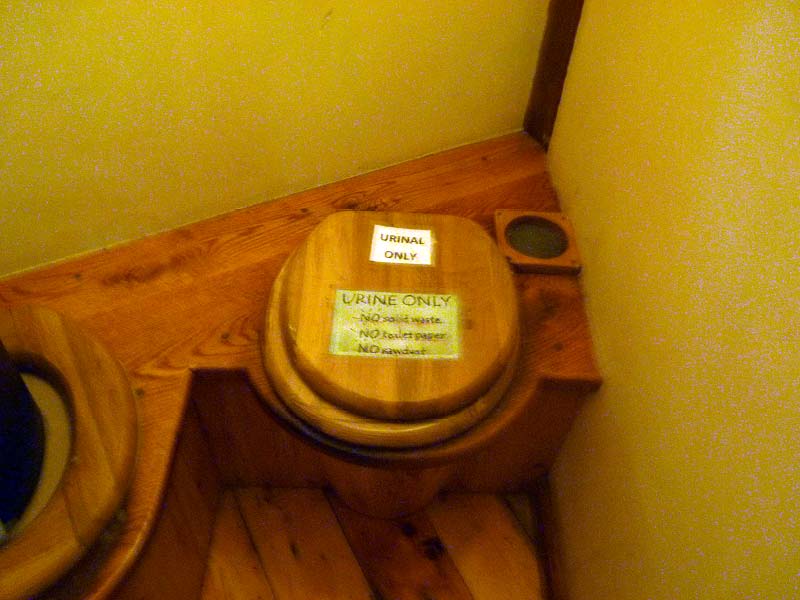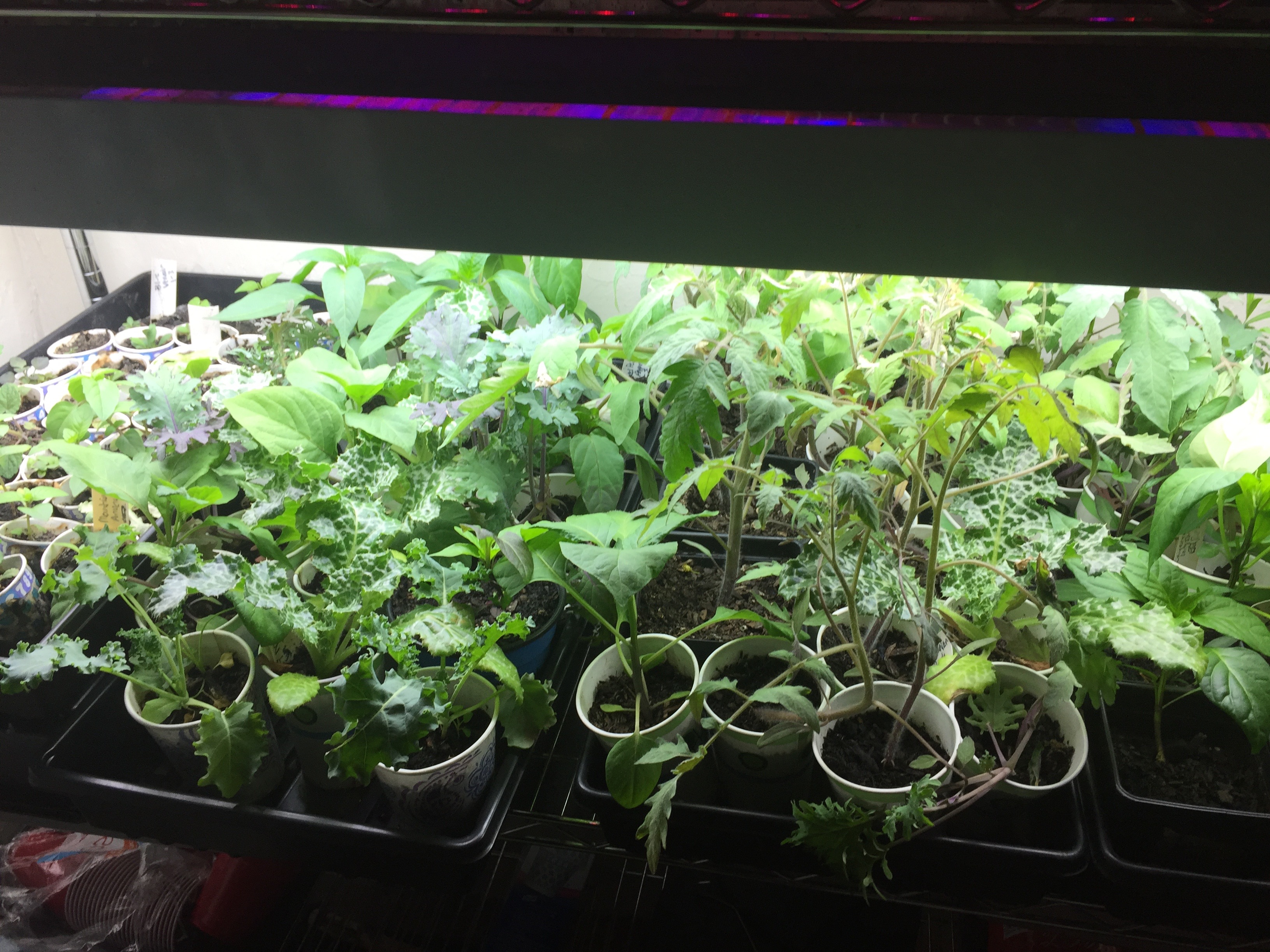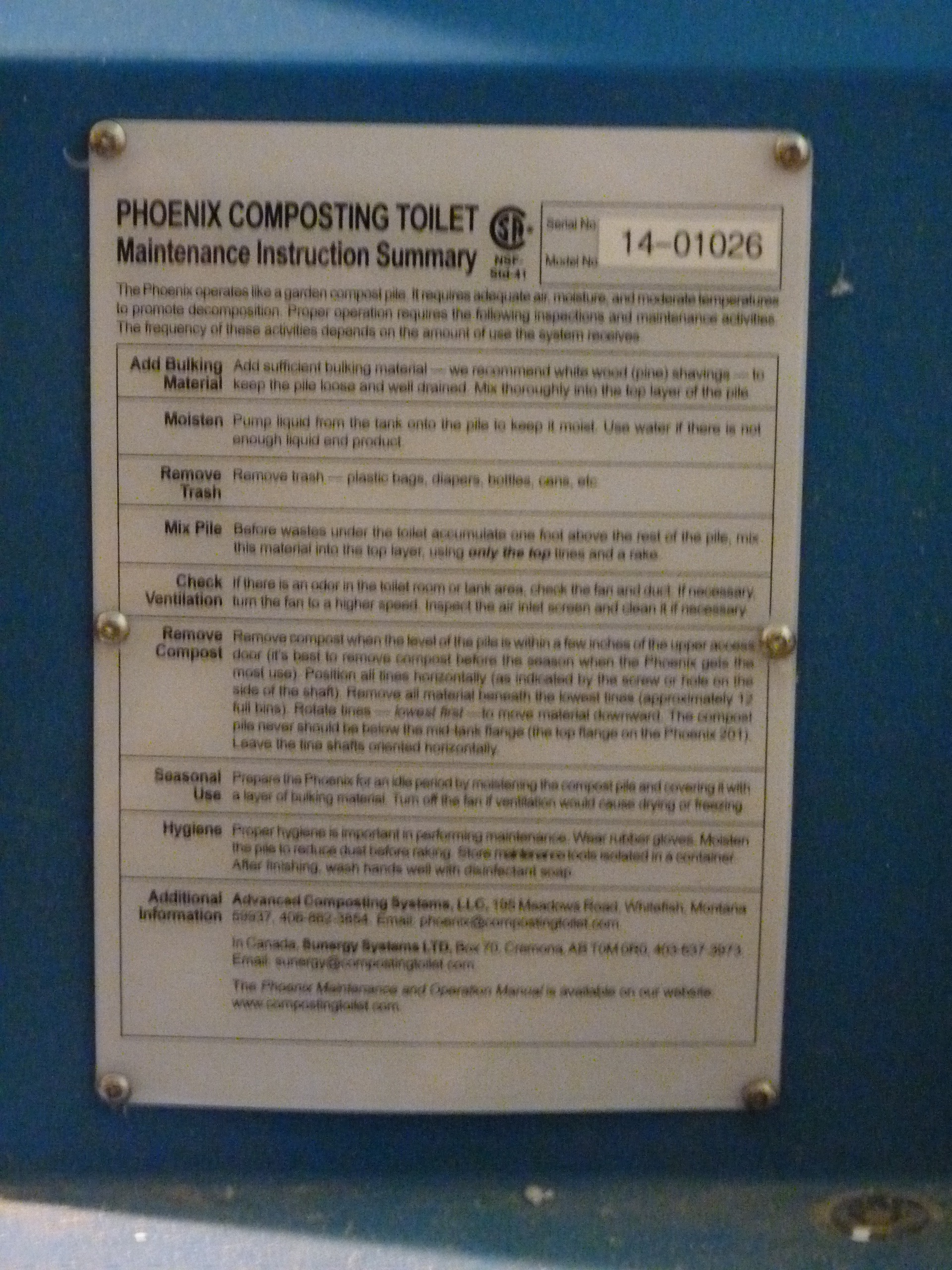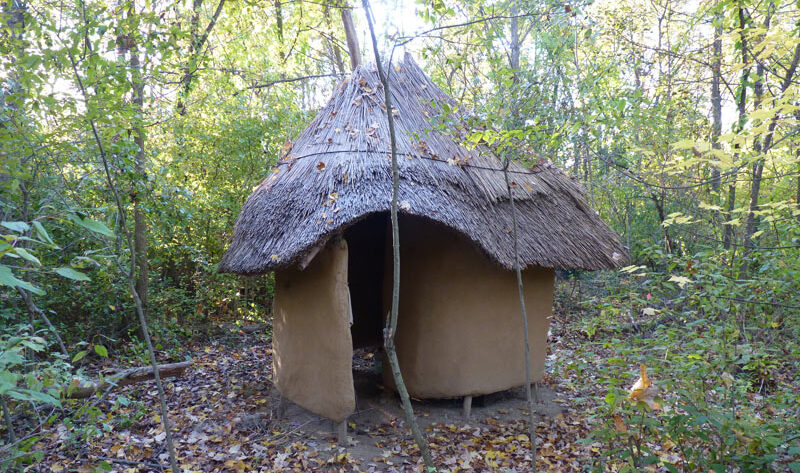
When I spent two weeks living in an ecovillage last summer, I proudly talked to friends and family about the fact that I hadn’t flushed a toilet in two weeks. This led to a wide assortment of responses, including “gross, ew” and others who were intrigued. My experience in living at the ecovillage helped better align me with my own waste streams. Each time I made any kind of deposit in the composting system at the ecovillage, I knew the waste my body no longer needed wasn’t going into some toxic sewage plant, but rather, back into the living landscape. And for that, I was grateful—I felt realigned with the land in a new and exciting way. And so, I worked to take that lesson back home with me in a few different ways since that time. For one, I’ve been doing experiments with small applications of urine as a fertilizer for my seedlings that I’m growing for my Refugia garden this year. After the application of “Liquid Gold” my seedlings are twice as big as they would otherwise typically be! So today, in the spirit of “spring cleaning” and for those looking to start new projects with spring energy swirling around us, I wanted to tackle this crappy topic! That topic is our own waste–and what to do with it. So today, we’ll explore humanure and liquid gold as useful resources for growing things.
Waste Not!
Humanity is literally drowning in its own waste, a topic not new to anyone who is paying attention. Even if we work to eliminate waste in other ways of our lives (as some of my earlier posts on disposing of the disposable mindset and dealing with materialism suggest), any “resources” our bodies produce is rarely discussed. The underlying problem is that modern industrialized society treats human waste like a toxic substance–but they are not. They are resources. I use the word bodily resources, rather than bodily waste because even the way that we frame these things in our speech matters. Our bodily resources are flushed into septic systems that are full of poison and require heavy amounts of fossil fuels and chemicals to process and address. But with a little rethinking and openness, we can get past the “gross” factor and start to see our own waste as a resource. And to help in that rethinking, I’ll point to two key permaculture principles: the problem is the solution and produces no waste.
So let’s follow the path that one flush takes to see the problem with human bodily resources–and where we might intervene and divert those waste streams to more productive uses. First, obviously, you begin by doing your business. If you are in the Western world or other industrialized places, you are doing your business often into gallons of perfectly acceptable drinking water (which is obviously also wasted).
After flushing, your waste can take two routes: a typical city or town dweller sends their flush directly into a municipal sewer system. If you live in a more rural area, it likely enters your private septic system, a type of holding tank, where it can partially break down, but eventually, the tank fills us. Then you call someone with a big truck that pumps it, and it ends up in the municipal septic system. So in both cases, let’s take a look at that municipal septic system.
Municipal septic systems are not just carrying human bodily resources. They take human” waste” and combine it with many other kinds of liquid (and sometimes solid) material “wastes” including stormwater runoff (more of that perfectly good and clean water running into the septic system, often mixed with oil from roadways, etc); industrial waste from various factories and processing plants (much of which can contain poisons, heavy metals, chemicals, etc), hospital waste (which can contain the disease, toxins, caustic cleaning agents, etc). Often present in this combined waste, from the many non-human waste streams, is something called “dioxins”, which are one of the most toxic chemicals on the earth. Dioxins are currently not regulated or tested by the EPA for sewage sludge that is applied to farmlands–and that’s a typical end result of these combined wastes after heavy processing. In fact, the information I linked above is the EPA’s argument for the non-regulation of dioxins. And radiation somehow ends up in there as well. Regulatory issues with dioxin and radiation aside, on the basic level, we take perfectly good material (human, stormwater, water from flushing) and mix it with really toxic waste, and then process the heck out of it (with more waste, chemicals, etc) to try to salvage something that is really not good at all that we spread on the fields that grow our food. Ew, ick. And you thought human poo was bad?

A Closed Loop System Humanure and Liquid Gold
We can work to keep our human bodily resources out of the municipal septic system, and cycle it back into the ecosystem in careful and mindful ways–and now we’ll explore ways of doing so. In fact, the idea that human waste is a resource is not a new concept. For millennia, humans collected and used their own feces and urine effectively.
The underlying principle here is simple: if at all possible, we want to create a closed-loop system in our living. This means that rather than nutrients and resources being in a line, like this: natural resource–> factory/farm–>store–>consumer–>garbage; we want to have system that instead functions like a circle, cycling nutrients, like this: garden plot –> you–> feces/urine –> compost –> garden plot. This closed-loop system is infinitely recycling and sustaining if all resources are harnessed. The truth is that human bodily resources are actually quite good for fertilizer when treated properly. The nutrients that your body doesn’t need, and the waste your body produces, can be cycled back into the nutrient cycle of life–meaning, its not waste at all, but a resource! Human pee is the same–it is liquid gold for good reason! So let’s explore these resources and how they can be harnessed and used.
Liquid Gold

Liquid gold is the much easier of the two to collect and use for the direct benefit of green, growing things, and so we’ll start with that process (and this is the one I have the most experience with). Urine had (and in some places, has) a whole industry built up around it in many parts of the world: from being used as a fertilizer, to medicine, to a teeth whitener, to an ingredient in gunpowder! I’m not going to go into such detail here about the many uses of urine, but I do think it is worth exploring some options for recycling our nutrients.
Human urine has incredible amounts of nitrogen–so much that if you pee directly on plants (or pour urine on them) it will burn them due to the high nitrogen content. It also has potassium, phosphorous, sulfur, magnesium, and calcium (see the Permaculture News article here for more info). Nitrogen is one of the key elements of plant growth; and I’ll take a moment here to again point out how humans and plants co-exist in such a complex web of interactions. We pee the plants’ most important nutrient–nitrogen; and we exhale carbon dioxide–both of these they take in and transform back for us. This incredible cycle only works when we let it.
Our urine is sterile, and it is, therefore, safe to use as a direct foliar spray on plants and trees with a 10% dilution (10% urine, 90% water). If you have a vegetable garden, you can add liquid gold, at the 10%/90% water ratio, in a backpack sprayer and simply spray your plants every few weeks. The alternative, that seems to work just as well for seedlings, is to use it just like any fertilizer you add to the water for watering the plants (again, 10% dilution, and I kind of eyeball this and don’t measure it exactly.) Add this in your garden how you would other compost teas–usually as a side dressing.
You can collect urine in any way you like–in an elaborate system, like at the ecovillage, every guest’s urine is diverted and used on extensive gardening systems each time they visit the urinal. But you can also collect urine in the most simple system, like a wide-mouth canning jar. It doesn’t necessarily take a long time to collect enough to be used for plants (indoor, outdoor, or seedlings)–think a few hours of collection for weekly watering of indoor plants. And you don’t need to use the liquid gold every week–I usually use it every 2 weeks and my plants are very happy. You do want to use the liquid gold fairly quickly, as it starts to turn to ammonia and develops a stronger smell.
After returning home from the Ecovillage, and especially with my seed starting this year, I started using liquid gold even with my small potted plants and house plants. It was incredible to see the difference—urine is almost pure nitrogen, and that is a resource indeed! My bay plant, which was suffering some aphid damage, quickly sprouted a ton of new growth. My baby tomato and pepper plants for my garden plot and an assortment of herbs are twice as big as they should be at this point in their growth! It’s really amazing stuff (and I am going to do some scientific experimentation on it in my community garden plot this summer and report back). You can read more about urine and how to use it as fertilizer in a book called Liquid Gold.
Humanure and Composting Toilets

The modern term for human feces that is properly composted is called “humanure” (coined by Jenkins in the Humanure Handbook). Humanure, once finished, is a lot like other kinds of organic compost–it contains microorganisms, a lot of dark, rich, organic matter, and a lot of carbon for the use of plants. It can be created and used no differently than other fertilizers if composted properly (two years, minimum). Most people who make humanure that I know only use it on perennial trees and/or simply return it to the forest since people would get weird about eating veggies grown in humanure. I think as long as you are taking it back into the ecosystem, sharing it with any plants is a good idea, and your comfort level determines the rest. The process of composting is really simple, and not much different than other forms of composting. Compost piles really stink when human pee and poop are added together, so most of the advanced systems separate the two (such as the photo of the urinal above).
Most systems begin with a composting toilet. There are many models of composting toilets—and seeing which kind you can use depends a great deal on the codes and regulations where you live. Sometimes, the easiest way to do this is to keep the regular toilet and septic tank there in your house (legally required), but to have a simple alternative system. Most alternative systems are not complicated or expensive – a 5-gallon bucket with a lid (you can get both for about $25) and a second bucket full of wood chips or other absorbent woody/carbon-rich material (some people use peat moss, but I don’t recommend it due to its unsustainable harvest; find a local resource instead if possible). And then, the management is simple enough. You use the bucket, and each time you do, you add 1 scoop for yellow and two scoops for brown. This is composted outside or in an enclosed place that is turned occasionally. It is generally composed for a minimum of two years before being added to fruit trees or other woody perennials.

Much more elaborate, permanent systems can be built or purchased—the most expensive I saw during my PDC was a self-contained unit that was put in a basement right above the toilet (photos in this section)—this system was about $8000; it was self-contained, odor-free, and literally had a spot where you came in and shoveled out rich compost (see the photos). It was that simple!
A more elaborate self-built system, like what was at Sirius Ecovillage, diverts urine and feces into separate places. Feces is composted as usual, often in large pits beneath the bathrooms that are dug out very occasionally; a solar-powered fan moves any odor out and away. Their system was great because it used mostly time to do the work. They had double toilets in each stall, one would be “composting” and be closed to new deposits, and one would be active. The active one would eventually fill up, and then they would switch to the other side. The one that is full was given a year or so to break down, and then it was scooped out and the process began again. It was very elegant, not at all smelly, and really effective.
The Humanure Handbook, in its full form, can be downloaded in PDF format. It gives many more options for you if you are interested in pursuing this path!
Humanure and Liquid Gold as Offerings
I’m going to propose an even more radical idea here—our human bodily resources can be seen as an offering and resource to the land. Humans in ages past knew our waste wasn’t waste at all, but was a valuable resource. Think about it—when we make an offering as part of ritual, say, a shiny penny as some traditions may use, what good does that offering do? It’s symbolic, yes, but our lands are in such duress. Around here, logging abounds, and resources are always being taken away, never added to our forests and wild areas. So, wouldn’t a direct offering of nitrogen be a better choice? Given this, I have begun making offerings when I go into the forest. For solid offerings, I bring a small trowel and make a hole six inches down, working hard not to disrupt the soil web more than necessary (See the book How to Take a Shit in the Woods for detailed instructions). For liquid offerings, I make sure not to pee directly on any plants, but I do pee near the base of trees or directly on the ground, as they can take a direct application of rich nitrogen. I know this seems radical, but from a plant’s perspective, it’s just more nutrients to be gained! And since I do wild food foraging, I do think that “giving back” a little is an important part of this. I want to give back more than I take, in all things. And this approach allows me to continue to cultivate that balance.
Conclusion
I hope you enjoyed this week’s post–it’s certainly something to consider, moving forward, into paths of deeper sustainability and awareness. Using “liquid gold” instead of regular plant fertilizer can, certainly, reduce your dependence on fossil fuels and synthetic fertilizer, and bring you in closer connection with your own plants. I would encourage you, if nothing else, to try using liquid gold for a month or two on plants and see how it goes! (As a fun note, I’ll link here to my very first blog post ever, which had a similar title, and talked about how I was using local horse manure for my garden and how sacred that substance was!)



Really interesting and enlightening! Love your site, btw.
Thank you for the comment and for reading!
I sincerely hope my urine is not sterile! 😉 In all seriousness, the notion that sterile niches might exist within the living ecosystem of my body strikes me as more than a little off-putting, as if I was walking around with some sort of nasty dead zone in my bladder. It seems more likely to me that there are low levels of good flora in there, doing their thing. This relatively recent study agrees—the researchers found evidence that genetic material from least 33 genera of bacteria were present in the urine of normal, healthy women. My understanding is that urine also picks up a certain amount of bacteria from the surfaces of the body during the process of urination, in any case.
I thought I would mention this because I am feeling an uncomfortable tension between the suggestion in your post that a substance would be safe to use as fertilizer because it is sterile, versus the more general life-affirming quality of both this particular essay and your overall outlook as a whole. My personal perspective is that a dilution of liquid gold from a healthy urinary tract would probably be safe to use on plants without the necessity of it being (entirely) sterile.
Hi Tracy, thanks for the info. Apparently scientists only discovered this like a year ago, and I hadn’t heard that, and the books I was working with for this post are from before then :). Regardless, thanks for your feedback! And yes, its a life affirming substance, regardless :).
My compostable toilet is simple: A 5 gallon bucket – after each “deposit” I add a couple scoops of ashes from the woodstove. The ashes keep away flies (and smell!) and break everything down fairly quickly. As long as I let the bucket sit for a few weeks before dumping it out, it does not at all resemble poo / toilet paper, and doesn’t smell at all.
Hi! Does that result in compost that is really alkali? Here in PA we have really acidic soil and that might be very welcome. But when I had my homestead in Michigan, my soil pH was very high. I don’t know if I would use wood ash in that case. And you add toilet paper as well? This sounds like a really interesting strategy. I’m particularly excited about stuff that’s not peat moss that is still very absorbent.
Yea, the ashes make it quite alkali. Just poo, toilet paper, & lots of wood ash. After letting it break down in the bucket for several weeks (keeping it topped off with ashes), I dump that into one of our ongoing compost piles where it can break down even more.
Thanks Dana!
A topic close to my heart and one I keep bringing up to people who work for the city. LOL, I get some uncomfortable looks and silences, but every once in awhile, I run into someone willing to read the Humanure Handbook. I use liquid good on any struggling plants, and they go gangbusters after the application.
David and so were thinking of you today. We are in Lafayette tonight, headed to Turkey Runntomorrow. I have photos of this amazing flower we saw at Clegg Botanic Gardens. I have never seen anything like it, but told David, “Oh, I’ll send the photo to Dana. She’ll know.” Anyway, we are finally on our journey to Turkey Run. Thanks for the recommendation, and thanks for posting about human resources!
Oops! Sorry for all the typos. I am on my phone. Autocorrect has gone rogue.
LOL, no worries, Laura!
I cannot express just how much I love this post. I’ve made liquid gold offerings to trees for years out of instinct. Great to have some science to back it up!
Cat, I’m so glad to hear! The trees approve 🙂
[…] something else earthy, consider this: “Holy Shit! Humanure and Liquid Gold as Ecological Resources” – and potential […]
Thank you for the reblog!
Be careful with horse manure. Many of us use ivermectin as a paste wormer for our horses, and it will kill your wormies if you have earthworms or composting worms. Learned that the hard way 🙁
How long does that last? I had horse manure that was about 6 years old, composted. Worms seemed to be fine in it 🙂
I have used humanure and liquid gold for years. I read Humanure and that was that. I use plain sandy soil from my 5 acres for feces, and collect liquid gold separately. I tend to add liquid gold to my regular compost pile here, because it is heavy in deadwood. I also use it on houseplants. In addition to nutrition, in my dry southwest garden, it is a
source of life giving water. As for using wood ashes, old outhouses used lime to keep odors down. My soil is very alkaline already, maybe that is why I don’t have an odor problem and it compost very quickly. I eventually use it around my pinyon-juniper forest.
Thanks for the comments, Rebecca! Thanks for your inspiration–adding liquid gold to the compost pile is a great idea. I used to have my guests pee on my comfrey patch, next to my compost pile. And thanks for the info on lime…good to know!
Hi Dana,
I have been using a Jenkins Humanure toilet for 7 years now. We add urine, feces and toilet paper to the dry leaves, moss from our pasture or wood shavings in the bucket. It does not smell bad. In composting, if it stinks, it needs more carbon. By the way, toilet paper is just a form of carbon. So put some more dry leaves in the bucket if it stinks. Then, every morning, the bucket gets emptied into a compost box that starts off with two bales of hay in it. The compost box is filled up for a year, never turned and left for an additional year. At the end of the two year process, I have a large box full of worm castings and it works wonders on my flower garden.
Yours under the red cedar,
Max Rogers
That sounds great, Max! Do you have some photos of your setup you can share?
Quite fascinating- thank you for sharing this! It is a subject i have been wondering about lately, from ‘the only good waste is no waste’ point of view. And i have been eyeing my plants with a full bladder for a while so it was a nice confirmation lol. It makes a lot of sense and is a piece of practical magic that anyone can use. And i also appreciate reading all the comments from people with their own experiences to share! Thank you Dana for this great post!
Lori, yes, it is a great practice! For outdoor plants, I try to pee on the roots, not on the leaves, as too much nitrogen will burn them. But we literally pee what plants need to survive–it is so amazing if you think about it :). Thanks for reading and for the comment!
Hello Dana.. we live a mostly permacultural inspred life, but my one true failing is that i could not persuade hubby that we must have composting toilets.. Our neighbours down the road have two, one on their earlier cabin and one on their home, and as he actually studied these things at Uni his are the cleanest I’ve ever seen (and there are lots of them in this area). I’ve been down with him when he shovelled out the completed matter and it is briilliant.. i’m trying to get him onside to persuade hubby.. they have no compost bins or anthung, just their composting toilets which do the whole shabang. Soooo jealous! but the liquid gold.. yes! That one I have been using with love for a long while.. if baby seedlings are looking saggy, they get a very gentle shower of very dilute golden tea, and my shadehouse plants, which include both rainforset babies and drier living natives for little bird habitat, all love it, despite their usual preference for different mixes.. Always accessible, free, and, yes, it saves flushing toilets.. xx
I hope we can truly move toward a more connected and symbiotic relationship with the earth and this is a great idea. My concern is the pharmaceuticals that are so prevalent today. I read that most species can utilize about 30% of the drugs for use and the rest is removed and expelled in our waste, contaminating the humanure. Not sure this is at all good for the planet.
Hi Barbara,
I think that when you are pooping in your own bucket, you know exactly what is being put in the bucket. You know what medicines you are on if any. I use a lot more herbs and herbal remedies, using pharmaceuticals only as a last resort. Because of this, I feel comfortable with my own waste. But I can see how this is a concern for others or more general larger compost systems, like those in intentional communities.
[…] uma pequena quantidade, e comprei um regador maior e um pouco de fertilizante orgânico (usei meupróprio ouro líquido , mas isso certamente não é algo que eu ia dizer a ela!) e, […]